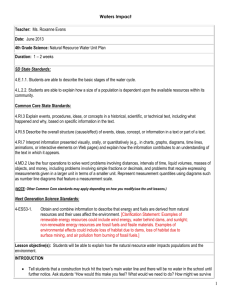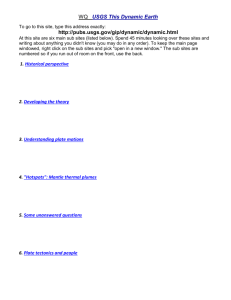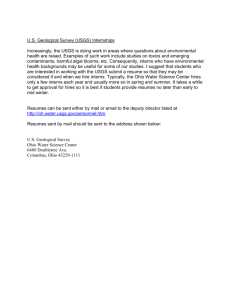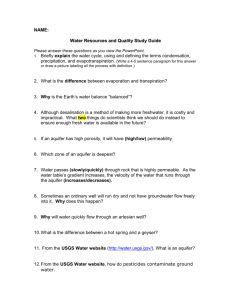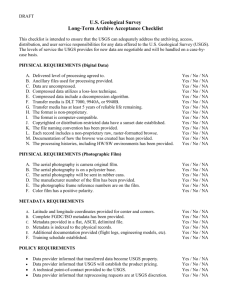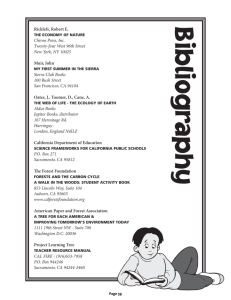One if by land, two if by sea - Natural Resource Ecology Laboratory
advertisement
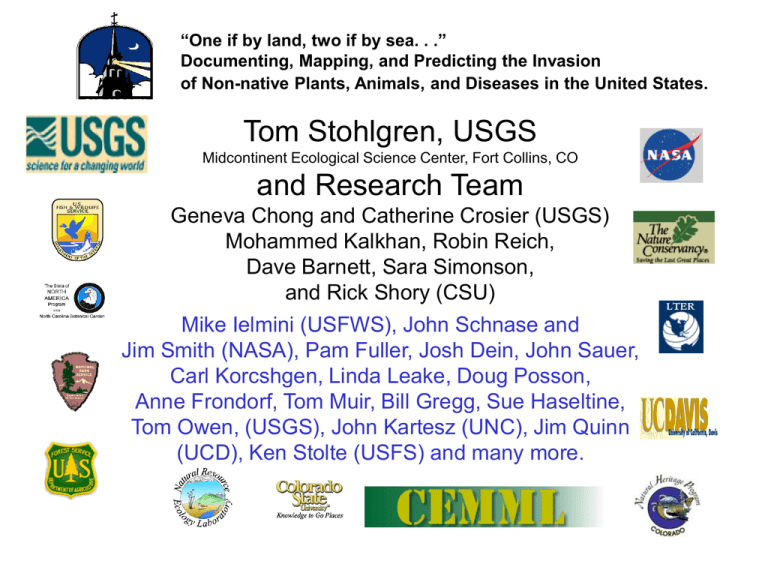
“One if by land, two if by sea. . .” Documenting, Mapping, and Predicting the Invasion of Non-native Plants, Animals, and Diseases in the United States. Tom Stohlgren, USGS Midcontinent Ecological Science Center, Fort Collins, CO and Research Team Geneva Chong and Catherine Crosier (USGS) Mohammed Kalkhan, Robin Reich, Dave Barnett, Sara Simonson, and Rick Shory (CSU) Mike Ielmini (USFWS), John Schnase and Jim Smith (NASA), Pam Fuller, Josh Dein, John Sauer, Carl Korcshgen, Linda Leake, Doug Posson, Anne Frondorf, Tom Muir, Bill Gregg, Sue Haseltine, Tom Owen, (USGS), John Kartesz (UNC), Jim Quinn (UCD), Ken Stolte (USFS) and many more. Invasive Species: The Top Environmental Issue of the 21st Century • Economic costs ($138 Billion/year). • Environmental costs (40% of Threatened and Endangered Species, many native species declines). • Human-health costs (West Nile Virus, Aids, malaria, others on the way). • Increased unintentional spread, or threat of ecological terrorism (hoofand-mouth, mad cow disease, crop pathogens). Notorious examples include Dutch elm disease, chestnut blight, and purple loosestrife in the northeast; kudzu, Brazilian peppertree, water hyacinth, nutria, and fire ants in the southeast; zebra mussels, leafy spurge, and Asian long-horn beetles in the Midwest; salt cedar, Russian olive, and Africanized bees in the southwest; yellow star thistle, European wild oats, oak wilt disease, Asian clams, and white pine blister rust in California; cheatgrass, various knapweeds and thistles in the Great Basin; whirling disease of salmonids in the northwest; hundreds of invasive species from microbes to mammals in Hawaii; and the brown tree snake in Guam. Hundreds new each year! Why Us, Why Now? • There are many data collectors, but few scientists who specialize in data synthesis and predictive modeling at multiple scales. • The USGS, with the cooperation of many partners, is uniquely qualified to lead invasive species research that integrates species traits, vulnerability of populations and habitats to invasion, early detection, risk analysis, and predictive models for “ecological forecasting.” • There is extreme urgency at local, regional, and national scales – the invasion is not only underway, it is accelerating and we’re unprepared. Why Us, Why Right Now? • Our expanded research team was tired of writing “white papers, budget initiatives, and progress reports on “case studies.” We want to accomplish much more! • Clients (USFWS, BLM, USFS, NPS, states) demanded that we synthesis data, design new surveys and monitoring methods, and rapidly develop predictive models for better early detection and control of many invasive species. • We approached several colleagues to begin a “data cooperative” of sorts – the first nation-wide collection of data on non-native plants, animals, and diseases integrated with new capabilities for the predictive modeling of species, populations, and habitats at multiple scales. • The response has been incredible! We must seize the moment! On the Policy Front: • The U.S. is beginning the development of the “Implementation Plan for the National Invasive Species Management Plan.” • APHIS is suggesting strong policy changes regarding the import of plants and animals. • There is increasing awareness of the effects of rapid biological invasions. “Needed: A National Center For Biological Invasions By Don Schmitz and Dan Simberloff” Issues in Science And Technology Summer 2001 DEPARTMENT OF AGRICULTURE Animal and Plant Health Inspection Service 7 CFR Part 330 [Docket No. 95-095-2] RIN 05789-AA80 Plant Pest Regulations; Update of Current Provisions AGENCY: Animal and Plant Health Inspection Service, USDA. ACTION: Proposed Rule. On the Science Front: • Better survey and monitoring techniques have been developed. (multi-phase, multiscale, nested-intensity designs). • Better modeling techniques have been developed. • More access and uses of high performance computing capabilities (Beowulf clusters, supercomputers, leased power). • Fewer barriers exist to sharing data. 40 40 Native Species 30 30 50 30 40 20 0 20 50 40 10 10 1 0. YCOORD % Soil N 30 0 0 10 20 30 40 40 1 2 20 30 40 50 % Soil Clay 3 33 2 2 20 20 5 4 10 10 20 30 XCOORD 10 10 0 0 10 30 34 20 0 40 Exotic Species 30 0 40 0 0 10 20 30 XCOORD 40 50 Current information capabilities: analysis and outreach, primarily with USGS data Fish + Aquatic plants Birds + Mammals California Wildlife Diseases Plants Hawaii Texas SW East/ South Midwest Taxonomic Approach (grossly under-funded, but national scale) Geographic Approach (slightly better funded, but locally scaled) Improving capabilities for synthesis, research, and outreach, with data from all sources Fish + Aquatic plants Birds + Mammals California Wildlife Diseases Web Tools for Research + Outreach Plants High Performance Computer Models Taxonomic Synergies Hawaii Texas Reston/ MESC High Resolution Habitat Maps East/ South SW Midwest Thematic Approach Geographic Synergies Data Synergies: inputs for early detection, risk assessment, and “ecological forecasting” models Num be r of S pe cies 1 - 51 51 - 120 120 - 19 7 197 - 30 3 303 - 67 4 No Data Data Synergies: Weeds in Colorado •County Quarter-Quad •National Parks, National Refuges, and Military Lands, LTER sites. •Forest Health Monitoring Plots, other forest data. •County Level Data •Natural Heritage Network •Modified Whittaker Plots (USGS and others) •Nature Conservancy INPUTS OUTPUTS County-level data on vascular plants (BONAP) Distributed National data on birds, mammals, and diseases (USGS) Information Management and modeling (USGS, NASA, CSU, UCD) Predictive models of habitats vulnerable to invasion Watershed-level data on fishes (USGS) •Data gathering • Species taxonomy • Data formatting • Synthesis • Predictive modeling • Analysis and display tools • Data accessibility via the web Predictive models of the spread of Invasive species Point data on public lands (USFWS, NPS, USGS) Vegetation and soils plot data (USFS, USGS, BLM) CLEARING HOUSE Web-net National-scale maps of non-native species distributions National, regional, and local priorities for control efforts Reports on the status and trends of non-native species in the U.S. Current Predictive Modeling Capabilities 1. ArcGIS: Input satellite data, veg., soils, topography, etc. Field Data: Invasive species data, veg., soils, topography, etc. 2. S-Plus: Develop Multivariate Model,screen and normalize data, test for tolerance/multi-colinearity, and run stepwise regression. 3. S-Plus: test residuals for auto-correlation and cross-correlation (Morans-I) and find the best model (ordinary least squares, gausian, etc. using AICC criteria). 4. 5. 6. S-Plus/Fortran: If spatially autocorrelated, run kriging or co-kriging models. ArcInfo GIS: develop map of model uncertainty from S-Plus output, Monte-Carlo simulations, observed-expected values. ArcView: produce maps of current distributions, potential distributions, and vulnerable habitats, with known levels of uncertainty. Future “Ecological Forecasting” Models: Far more automated, instantaneous, and continuous! 1. ArcView: Input satellite data, via new sensors or change detection models. 2. Web-ware: • Develop multivariate model, screen and normalize data, test for tolerance/multi-colinearity, and run combinatorial screening. • Test residuals for auto-correlation and cross-correlation (Morans-I) and find the best models. • If spatial autocorrelation exists, run kriging or co-kriging models. • Develop map of models uncertainty (maps with standard errors). • Produce maps of current distributions, potential distributions, and vulnerable habitats, with known levels of uncertainty. OR Field Data: Early detection or monitoring data, from many sources. 3. Repeat Step 1 – always be looking for new data What do clients want? • Pick and click on any point, land management unit, county, state, or region and determine The current invasion, and vulnerability to future invasion by many species. (help public and private land managers). Refuge: LaCreek Wildlife Refuge South Dakota Updated:10/02/02 Regional zoom? Yes Metadata? Yes Plot data? Yes Control Info? Yes Plants P= Animals P= Diseases P= Cheatgrass 1.0 Norway rat 1.0 Blister rust .5 Musk thistle .99 Fire ants .01 plague Leafy spurge .65 Brown trout .01 Water hyacinth .02 Cover % Zoom? Yes Musk thistle Cardus iforgotus Plant ID Help? Yes Map Uncertainty? Yes .4 Or . . . Pick and click on any species or group of species, and get current distributions, potential distributions, potential rates of change, and levels of uncertainty. (We have much to learn here! HPCC example on West Nile Virus). Obstacles 1. Lack of data sharing. Solutions 1. Incentives, support, rewards for sharing. 2. Uncoordinated budget 2. Joint budget committee, process (DOI, USDA, Commerce). share “line items” ideas. 3. Computing power, leaving the “PC stage.” 3. Beowulf clusters, supercomputer use. 4. Modeling spatial and temporal variation simultaneously. 4. “Frontiers of science” challenge. 5. Urgency combined with inadequate funding. 5. Dedication combined with enthusiasm and perseverance. A growing list of partners: U.S. Geological Survey: T. Stohlgren, G. Chong, and C. Crosier (Midcontinent Ecological Science Center, plants, data management), J. Sauer (Patuxent Wildlife Research Center, birds, mammals), P. Fuller (Florida Caribbean Science Center, fish), J. Dein (National Wildlife Health Center, diseases), C. Korschgen (Columbia Environmental Research Center, web-tools), L. Leake ( Upper Midwest Environmental Science Center, data management), T. Owen (Center for Biological Informatics, information mapping), A. Frondorf (Reston Office, high-performance computing), M. Ruggiero (Integrated Taxonomic Information System, taxonomy, synonyms), W. Gregg (Invasive Species Coordinator, Reston Office). T. Muir, R. Westbrooks (early detection), S. Haseltine (HQ). U.S. Fish and Wildlife Service: M. Ielmini (Washington Office, Wildlife Refuges), W. King (Region 6 Wildlife Refuges). Biota of North America Program, University of North Carolina: J. Kartesz and M. Nishiko (plants). National Park Service: G. Williams (Inventory and Monitoring), C. Axtell (Biological Resource Management Division); M. Wotawa (Biological Inventories and NPSpecies). U.S. Forest Service: K. Stolte (Forest Health Monitoring Program). National Aeronautics and Space Administration: J. Schnase and J. Smith and several others (ecological forecasting, high-performance computing, remote sensing and modeling). Colorado State University/Natural Resources Ecology Laboratory: M. Kalkhan and R. Reich (Spatial modeling), D. Barnett, S. Simonson, R. Shory (data management, outreach). University of California, Davis: J. Quinn (information management, modeling). Long Term Ecological Research (LTER): J. Gosz Colorado Natural Heritage Program: B. Strom (director), A. Black (GIS specialist) Center for Environmental Management of Military Lands: B. Shaw The Nature Conservancy: A. Bartuska, J. Randall State of Colorado: E. Lane (State Weed Coordinator), B. Cheatum (GIS) Agriculture Experiment Station: L. Sommers Leveraging Funds, Data, and Expertise Funds: USFWS ($166K, $266K), NASA ($250K, $250K, $250K), BRD ($50K), USGS Venture Capital ($35K), MESC ($5K), State of Colorado Agriculture Experiment Station ($28K, $25K, $25K). Few USGS funds Data: USGS (6 centers), USFWS, BONAP, NPS, TNC, BLM, NPS, CEMML, UCD, UWY, USFS (FHM), State of Colorado, LTER, APHIS, and CNHP. data =$multiple millions Expertise: USGS (6 centers), NASA, EDC, CSU, USFWS, BONAP, NPS, TNC, BLM, NPS, CEMML, UCD, UWY, State of Colorado, LTER, ITIS, APHIS, CNHP, Students and post-docs. No new USGS FTEs “One if by land, two if by sea. . .” Documenting, Mapping, and Predicting the Invasion of Non-native Plants, Animals, and Diseases in the United States. The Future: It’s What We Make It! • Many more partnerships (DoD, CDC, APHIS, many universities, more states, and more agency offices). • Joint budget initiatives and proposals (coordinating at higher levels in each agency). • More shared expertise (data base design, web tools, metadata, parallel processing and programming, HPCC staff, additional modeling approaches). • More staff (discussing Ph.D. and post-doc options with several students, EDC, NBII, and APHIS). • “Status and Trends of the Nation’s Invasive Species” • A much larger “Invasive Species” program in the USGS – one of our 8 future science activities (We can’t do it alone, but we can do it together!)
